Co-dependency: The Relationship Addiction Essay - Psychology
VerifiedAdded on 2023/01/16
|6
|1115
|34
Essay
AI Summary
This essay delves into the concept of co-dependency, examining its characteristics, origins, and negative impacts on relationships. The author shares a personal experience of exhibiting co-dependent behavior within a friendship, detailing how the need for attention and approval from peers led to compliance patterns, low self-esteem, and a feeling of inadequacy. The essay explores the dynamics of this relationship, highlighting instances where the author suppressed personal beliefs and opinions to fit in, leading to a loss of self-awareness and a sense of manipulation. The author also discusses the fear of losing friends and the feeling of being incomplete without them. The essay concludes by emphasizing the importance of self-love and seeking professional advice as crucial steps in overcoming co-dependency. References to scholarly sources are included to support the analysis of this psychological phenomenon.
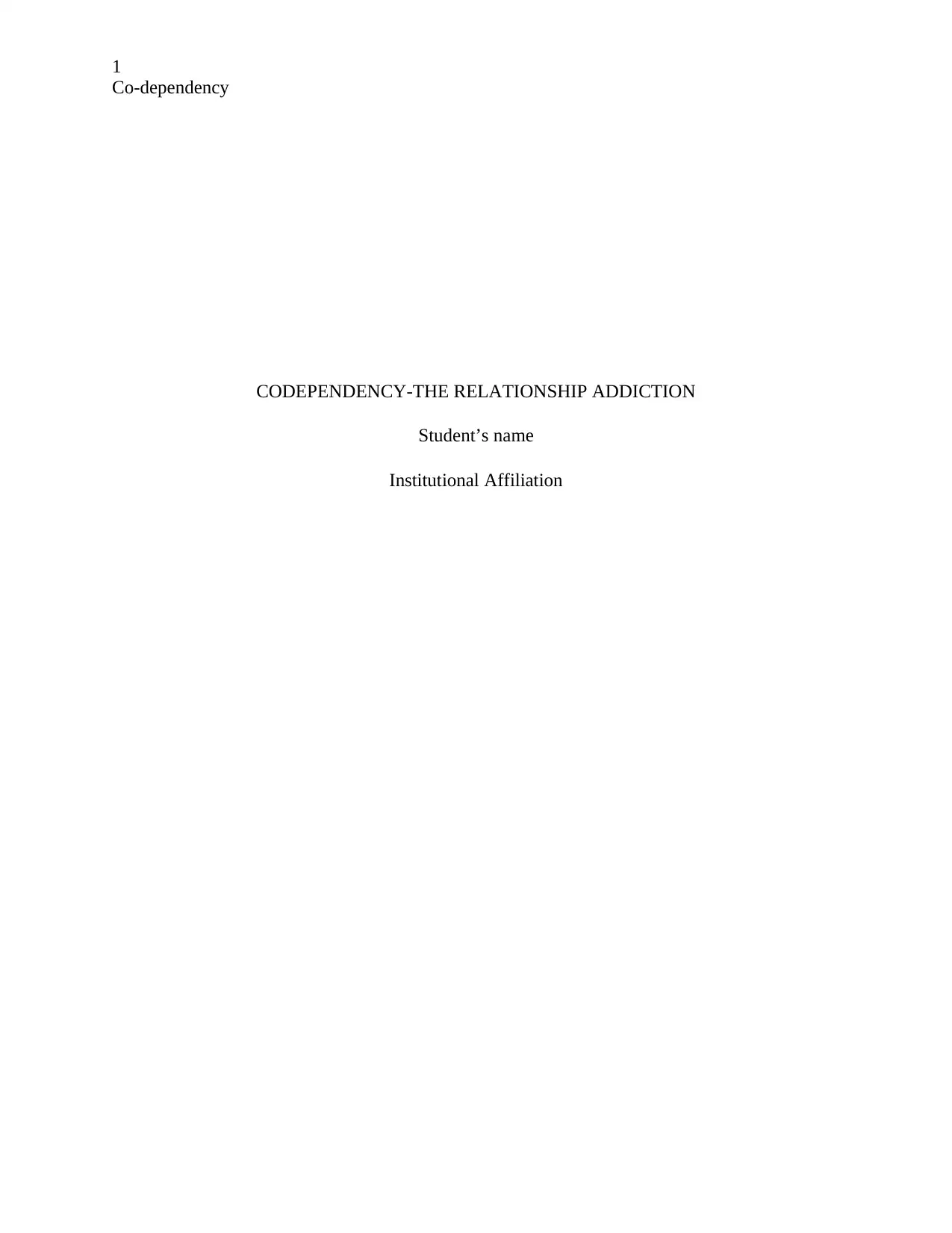
1
Co-dependency
CODEPENDENCY-THE RELATIONSHIP ADDICTION
Student’s name
Institutional Affiliation
Co-dependency
CODEPENDENCY-THE RELATIONSHIP ADDICTION
Student’s name
Institutional Affiliation
Paraphrase This Document
Need a fresh take? Get an instant paraphrase of this document with our AI Paraphraser
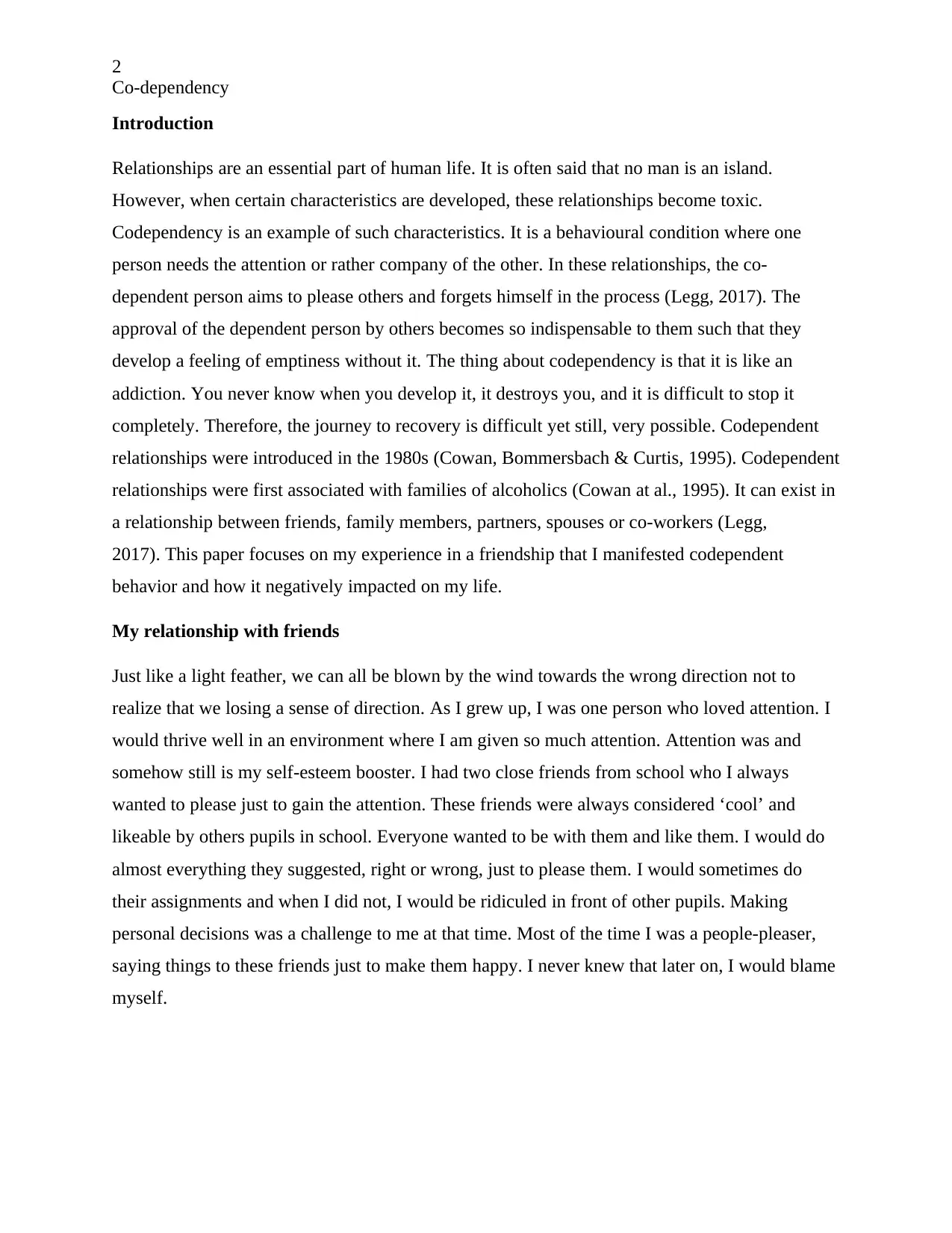
2
Co-dependency
Introduction
Relationships are an essential part of human life. It is often said that no man is an island.
However, when certain characteristics are developed, these relationships become toxic.
Codependency is an example of such characteristics. It is a behavioural condition where one
person needs the attention or rather company of the other. In these relationships, the co-
dependent person aims to please others and forgets himself in the process (Legg, 2017). The
approval of the dependent person by others becomes so indispensable to them such that they
develop a feeling of emptiness without it. The thing about codependency is that it is like an
addiction. You never know when you develop it, it destroys you, and it is difficult to stop it
completely. Therefore, the journey to recovery is difficult yet still, very possible. Codependent
relationships were introduced in the 1980s (Cowan, Bommersbach & Curtis, 1995). Codependent
relationships were first associated with families of alcoholics (Cowan at al., 1995). It can exist in
a relationship between friends, family members, partners, spouses or co-workers (Legg,
2017). This paper focuses on my experience in a friendship that I manifested codependent
behavior and how it negatively impacted on my life.
My relationship with friends
Just like a light feather, we can all be blown by the wind towards the wrong direction not to
realize that we losing a sense of direction. As I grew up, I was one person who loved attention. I
would thrive well in an environment where I am given so much attention. Attention was and
somehow still is my self-esteem booster. I had two close friends from school who I always
wanted to please just to gain the attention. These friends were always considered ‘cool’ and
likeable by others pupils in school. Everyone wanted to be with them and like them. I would do
almost everything they suggested, right or wrong, just to please them. I would sometimes do
their assignments and when I did not, I would be ridiculed in front of other pupils. Making
personal decisions was a challenge to me at that time. Most of the time I was a people-pleaser,
saying things to these friends just to make them happy. I never knew that later on, I would blame
myself.
Co-dependency
Introduction
Relationships are an essential part of human life. It is often said that no man is an island.
However, when certain characteristics are developed, these relationships become toxic.
Codependency is an example of such characteristics. It is a behavioural condition where one
person needs the attention or rather company of the other. In these relationships, the co-
dependent person aims to please others and forgets himself in the process (Legg, 2017). The
approval of the dependent person by others becomes so indispensable to them such that they
develop a feeling of emptiness without it. The thing about codependency is that it is like an
addiction. You never know when you develop it, it destroys you, and it is difficult to stop it
completely. Therefore, the journey to recovery is difficult yet still, very possible. Codependent
relationships were introduced in the 1980s (Cowan, Bommersbach & Curtis, 1995). Codependent
relationships were first associated with families of alcoholics (Cowan at al., 1995). It can exist in
a relationship between friends, family members, partners, spouses or co-workers (Legg,
2017). This paper focuses on my experience in a friendship that I manifested codependent
behavior and how it negatively impacted on my life.
My relationship with friends
Just like a light feather, we can all be blown by the wind towards the wrong direction not to
realize that we losing a sense of direction. As I grew up, I was one person who loved attention. I
would thrive well in an environment where I am given so much attention. Attention was and
somehow still is my self-esteem booster. I had two close friends from school who I always
wanted to please just to gain the attention. These friends were always considered ‘cool’ and
likeable by others pupils in school. Everyone wanted to be with them and like them. I would do
almost everything they suggested, right or wrong, just to please them. I would sometimes do
their assignments and when I did not, I would be ridiculed in front of other pupils. Making
personal decisions was a challenge to me at that time. Most of the time I was a people-pleaser,
saying things to these friends just to make them happy. I never knew that later on, I would blame
myself.
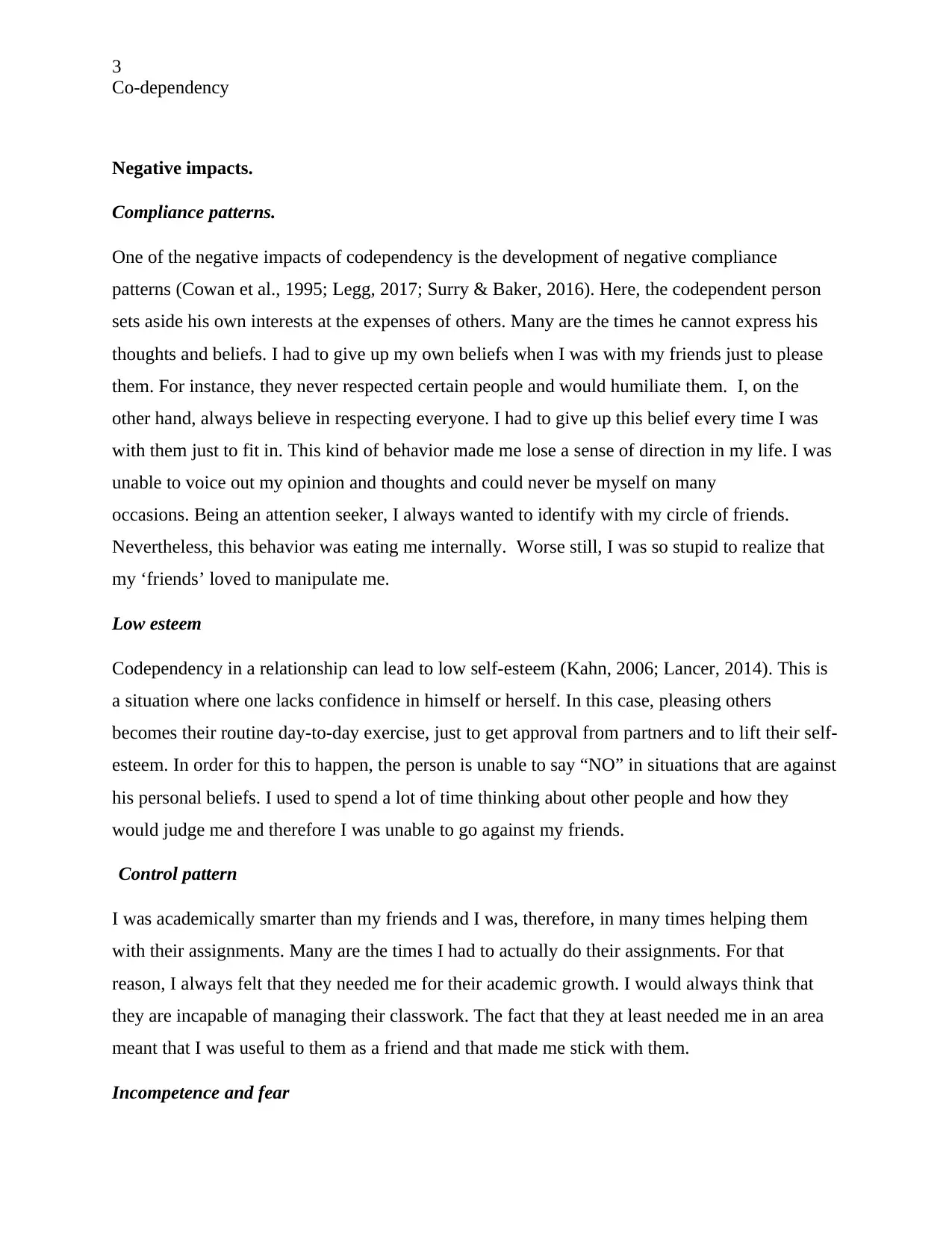
3
Co-dependency
Negative impacts.
Compliance patterns.
One of the negative impacts of codependency is the development of negative compliance
patterns (Cowan et al., 1995; Legg, 2017; Surry & Baker, 2016). Here, the codependent person
sets aside his own interests at the expenses of others. Many are the times he cannot express his
thoughts and beliefs. I had to give up my own beliefs when I was with my friends just to please
them. For instance, they never respected certain people and would humiliate them. I, on the
other hand, always believe in respecting everyone. I had to give up this belief every time I was
with them just to fit in. This kind of behavior made me lose a sense of direction in my life. I was
unable to voice out my opinion and thoughts and could never be myself on many
occasions. Being an attention seeker, I always wanted to identify with my circle of friends.
Nevertheless, this behavior was eating me internally. Worse still, I was so stupid to realize that
my ‘friends’ loved to manipulate me.
Low esteem
Codependency in a relationship can lead to low self-esteem (Kahn, 2006; Lancer, 2014). This is
a situation where one lacks confidence in himself or herself. In this case, pleasing others
becomes their routine day-to-day exercise, just to get approval from partners and to lift their self-
esteem. In order for this to happen, the person is unable to say “NO” in situations that are against
his personal beliefs. I used to spend a lot of time thinking about other people and how they
would judge me and therefore I was unable to go against my friends.
Control pattern
I was academically smarter than my friends and I was, therefore, in many times helping them
with their assignments. Many are the times I had to actually do their assignments. For that
reason, I always felt that they needed me for their academic growth. I would always think that
they are incapable of managing their classwork. The fact that they at least needed me in an area
meant that I was useful to them as a friend and that made me stick with them.
Incompetence and fear
Co-dependency
Negative impacts.
Compliance patterns.
One of the negative impacts of codependency is the development of negative compliance
patterns (Cowan et al., 1995; Legg, 2017; Surry & Baker, 2016). Here, the codependent person
sets aside his own interests at the expenses of others. Many are the times he cannot express his
thoughts and beliefs. I had to give up my own beliefs when I was with my friends just to please
them. For instance, they never respected certain people and would humiliate them. I, on the
other hand, always believe in respecting everyone. I had to give up this belief every time I was
with them just to fit in. This kind of behavior made me lose a sense of direction in my life. I was
unable to voice out my opinion and thoughts and could never be myself on many
occasions. Being an attention seeker, I always wanted to identify with my circle of friends.
Nevertheless, this behavior was eating me internally. Worse still, I was so stupid to realize that
my ‘friends’ loved to manipulate me.
Low esteem
Codependency in a relationship can lead to low self-esteem (Kahn, 2006; Lancer, 2014). This is
a situation where one lacks confidence in himself or herself. In this case, pleasing others
becomes their routine day-to-day exercise, just to get approval from partners and to lift their self-
esteem. In order for this to happen, the person is unable to say “NO” in situations that are against
his personal beliefs. I used to spend a lot of time thinking about other people and how they
would judge me and therefore I was unable to go against my friends.
Control pattern
I was academically smarter than my friends and I was, therefore, in many times helping them
with their assignments. Many are the times I had to actually do their assignments. For that
reason, I always felt that they needed me for their academic growth. I would always think that
they are incapable of managing their classwork. The fact that they at least needed me in an area
meant that I was useful to them as a friend and that made me stick with them.
Incompetence and fear
⊘ This is a preview!⊘
Do you want full access?
Subscribe today to unlock all pages.

Trusted by 1+ million students worldwide
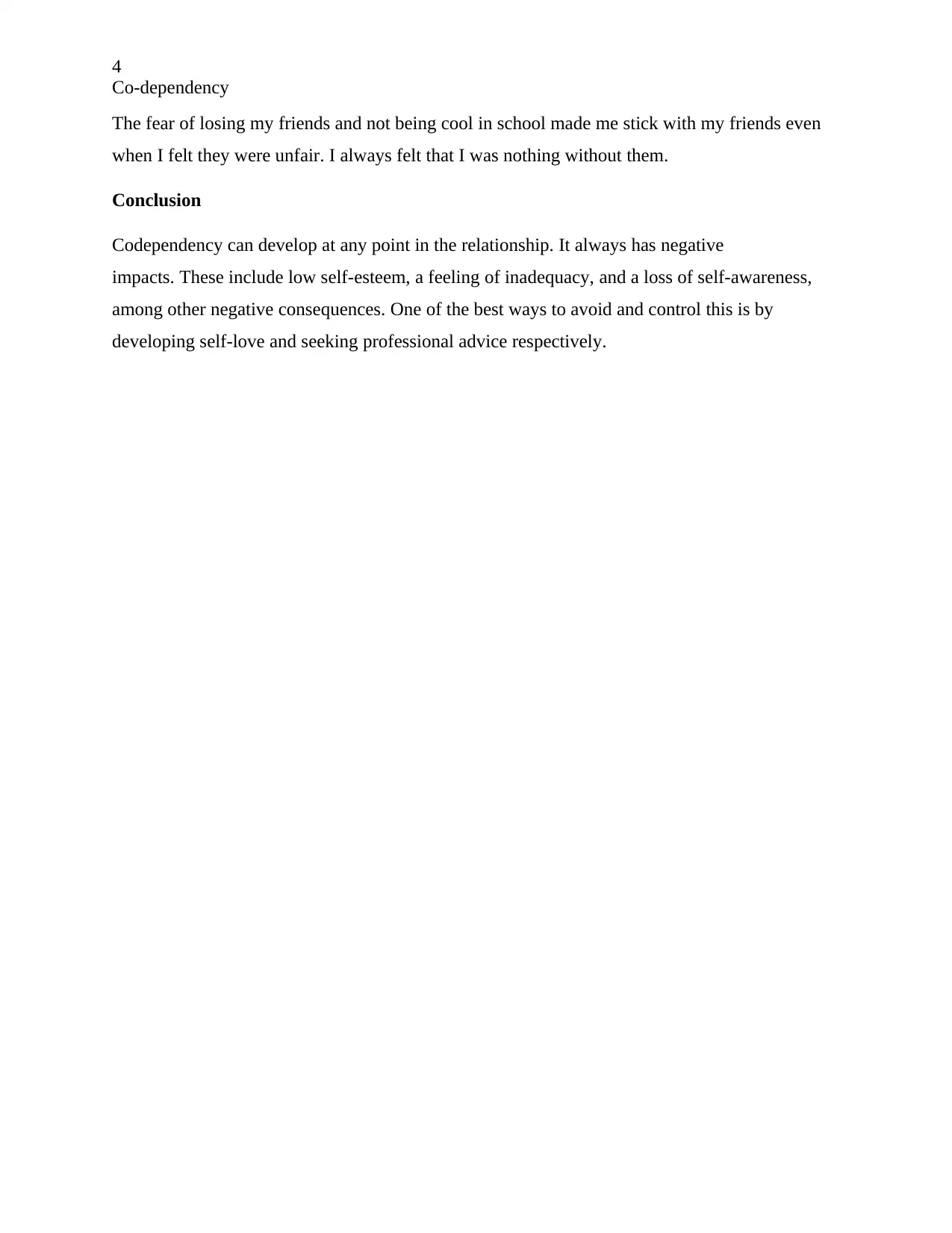
4
Co-dependency
The fear of losing my friends and not being cool in school made me stick with my friends even
when I felt they were unfair. I always felt that I was nothing without them.
Conclusion
Codependency can develop at any point in the relationship. It always has negative
impacts. These include low self-esteem, a feeling of inadequacy, and a loss of self-awareness,
among other negative consequences. One of the best ways to avoid and control this is by
developing self-love and seeking professional advice respectively.
Co-dependency
The fear of losing my friends and not being cool in school made me stick with my friends even
when I felt they were unfair. I always felt that I was nothing without them.
Conclusion
Codependency can develop at any point in the relationship. It always has negative
impacts. These include low self-esteem, a feeling of inadequacy, and a loss of self-awareness,
among other negative consequences. One of the best ways to avoid and control this is by
developing self-love and seeking professional advice respectively.
Paraphrase This Document
Need a fresh take? Get an instant paraphrase of this document with our AI Paraphraser

5
Co-dependency
Co-dependency
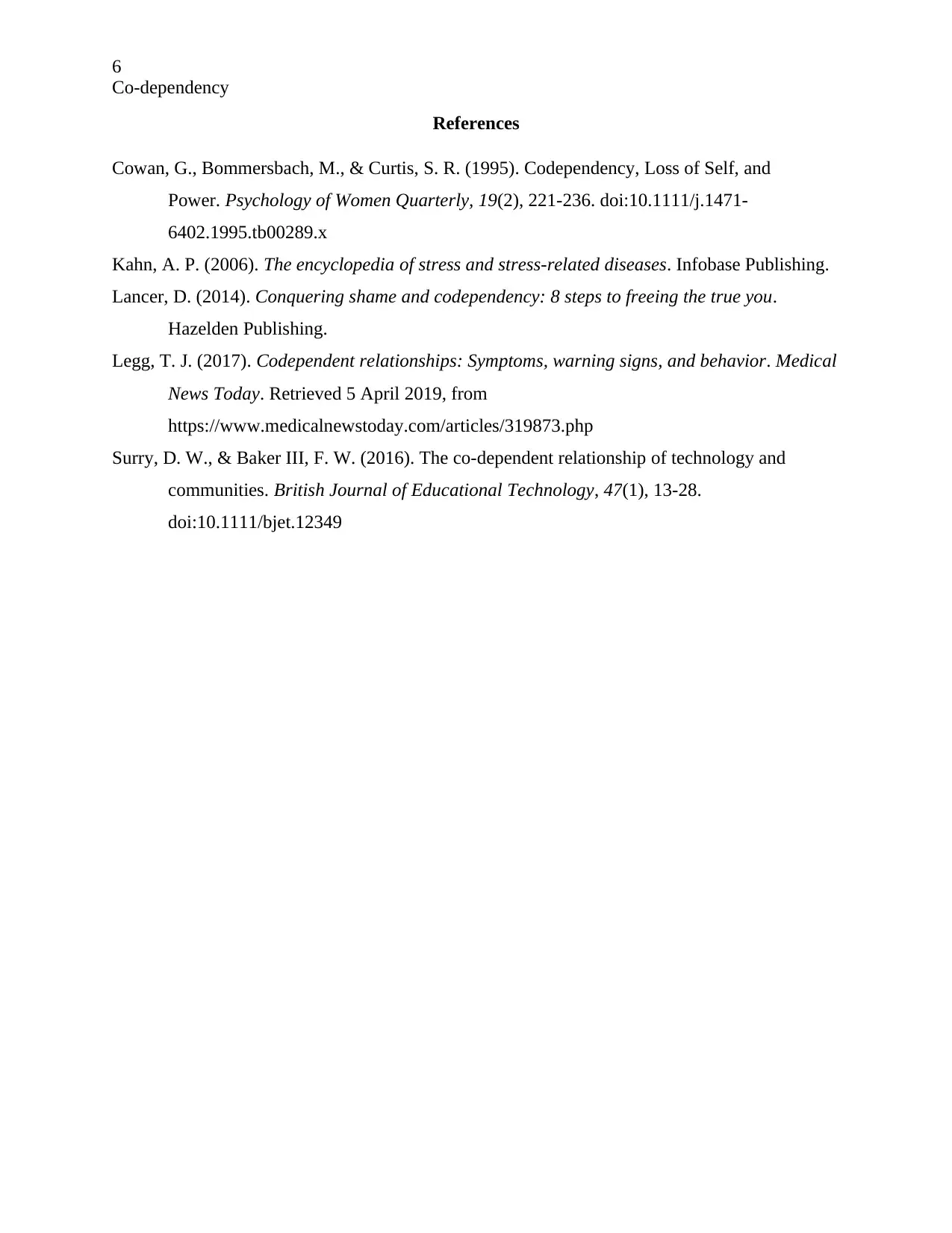
6
Co-dependency
References
Cowan, G., Bommersbach, M., & Curtis, S. R. (1995). Codependency, Loss of Self, and
Power. Psychology of Women Quarterly, 19(2), 221-236. doi:10.1111/j.1471-
6402.1995.tb00289.x
Kahn, A. P. (2006). The encyclopedia of stress and stress-related diseases. Infobase Publishing.
Lancer, D. (2014). Conquering shame and codependency: 8 steps to freeing the true you.
Hazelden Publishing.
Legg, T. J. (2017). Codependent relationships: Symptoms, warning signs, and behavior. Medical
News Today. Retrieved 5 April 2019, from
https://www.medicalnewstoday.com/articles/319873.php
Surry, D. W., & Baker III, F. W. (2016). The co‐dependent relationship of technology and
communities. British Journal of Educational Technology, 47(1), 13-28.
doi:10.1111/bjet.12349
Co-dependency
References
Cowan, G., Bommersbach, M., & Curtis, S. R. (1995). Codependency, Loss of Self, and
Power. Psychology of Women Quarterly, 19(2), 221-236. doi:10.1111/j.1471-
6402.1995.tb00289.x
Kahn, A. P. (2006). The encyclopedia of stress and stress-related diseases. Infobase Publishing.
Lancer, D. (2014). Conquering shame and codependency: 8 steps to freeing the true you.
Hazelden Publishing.
Legg, T. J. (2017). Codependent relationships: Symptoms, warning signs, and behavior. Medical
News Today. Retrieved 5 April 2019, from
https://www.medicalnewstoday.com/articles/319873.php
Surry, D. W., & Baker III, F. W. (2016). The co‐dependent relationship of technology and
communities. British Journal of Educational Technology, 47(1), 13-28.
doi:10.1111/bjet.12349
⊘ This is a preview!⊘
Do you want full access?
Subscribe today to unlock all pages.

Trusted by 1+ million students worldwide
1 out of 6
Related Documents
Your All-in-One AI-Powered Toolkit for Academic Success.
+13062052269
info@desklib.com
Available 24*7 on WhatsApp / Email
![[object Object]](/_next/static/media/star-bottom.7253800d.svg)
Unlock your academic potential
Copyright © 2020–2025 A2Z Services. All Rights Reserved. Developed and managed by ZUCOL.





